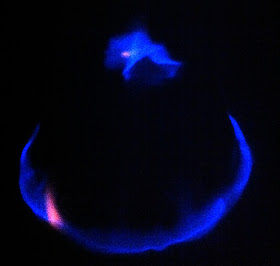This comes from a cookbook I bought in Colonial Williamsburg called The Art of Cookery Made Plain and Simple by Mrs. Glasse. On page 122 is a recipe entitled "To Make an Apple Pie", which seemed an appropriate place to start. This 1805 cookbook, filled with recipes from the 1700s, has its recipes in a format very different than those half a century later. There are no amounts and very little technique, it's basically just an ingredient list with brief explanation, and so a lot of interpretation was required. Here is an image of the entire recipe from the Google E-book:
In making the recipe there were basically 2 places where I had to use my own initiative (guess):
- There is no recipe in the book for puff pastry (I used a recipe from a modern cookbook)
- The amount of sugar required is highly subjective. (I used the least I could and get an even layer over the apples, under the assumption that it was a dear commodity)
- Obviously no baking time and temperature was given, so again I looked at a modern apple pie recipe
- Apple type: I honestly can't remember what i used, but I think it was Jonagolds. I would go with a sweeter apple and avoid the tarter ones, because of the limited sugar in the recipe.
I also had a deviation in terms of spices. Instead of adding cloves to the pie itself, which seemed unpleasant, I simply boiled them with the syrup. Also, i left out the mace. Nutmeg would make a good substitute, but I was unsure how much to add.
The final recipe as posted on my blog:
Make a dough out of 2c (250g) flour, 150ml water, and 8tbsp butter. Blend it enough so it forms a coherent dough, but has visible butter pieces in it. Roll it into a rectangle and fold the right third over the middle, then the left third over the middle. Place in refrigerator for 30min.
Then roll it back out into a rectangle, and put another 4tbsp butter (in thin pats) to cover the middle 3rd. Fold the edges as before and roll out into the rectangle. Fold the edges and refrigerate for 15min.
Meanwhile, core and peel 7 apples. Cut them into 8ths and add some lemon juice, put in the fridge. Boil the cores and peels for 10min with some cloves and strain. Add 1/4c sugar to the liquid and reboil until it forms a thick syrup (maybe another 10min),
Take the crust from the fridge and roll it out. Divide into two parts, one slightly larger and place in pie pan (you can do the folding trick more in 15min iterations if you want to get flakier crust). Add a layer of apples and sprinkle with 2tbspn sugar. Add second layer of apples, and sprinkle with 2tbspn sugar. Drizzle with the syrup.
Add top crust and bake at 425F for ~1hr. You can turn down to 350 if the crust seems to be browning too much.
So How did it work?
As you can see from the picture below, my first ever attempt at puff pastry became hugely puffy because I was a bit overenthusiastic in terms of layer numbers. I think 2 refrigeration sessions is more than enough.
Also, this is not a very sweet pie. It is definitely a pie that tastes mostly of the natural sweetness of apples, which makes it a good option for those avoiding processed sugar in their diets (leave sugar out and either add honey to the syrup making stage, or try boiling the cores and peels in apple juice instead of water).
Lastly, the part where you boil the peel and cores is really great. You get this beautiful pink pectin with a strong apple flavor. That technique is something I will carry forward into future apple pie attempts.






